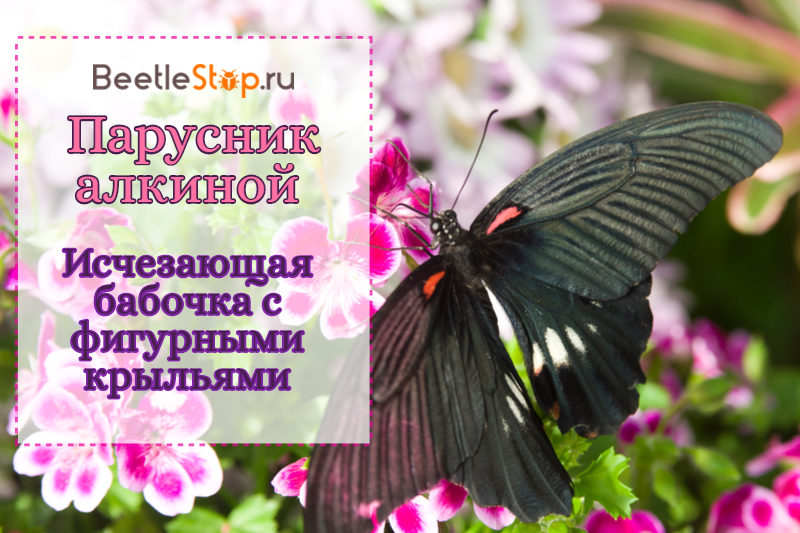Alkina butterfly - a rare seaside sailing ship
The family of sailboats or gentlemen combined large and medium butterflies with a special wing structure. A characteristic difference of the group is the edge of the hind wing cut along an arc at the point of contact with the abdomen. All members of the family, and there are about 570 species, lead a daily life. Alkina Butterfly is a sailboat found in Japan, China and the Amur Region. Caterpillars of this species are monophages feeding exclusively on Manchurian kirkazon. Poaching of the plant has led to a critical reduction in the population of butterflies in Russia.

View description
Alkaline sailboat (Byasaalcinous or Atrophaneuraalcinous) is a large butterfly with a wingspan of 84-90 mm. Sexual dimorphism of insects is expressed in color - in males the wings are black, and in females gray with black veins. The front wings are wide, triangular in shape, the posterior oval, elongated. The edges of the hind wings are wavy; a series of crescent-shaped spots of yellow or red color passes along the black border. The tail outgrowths, which are the hallmark of the family, reach a length of 2 cm. In size, they equal one third of the wing. Males alky butterflies on the abdomen and head have red spots.
The head of the insect is round, eyes are large, bare. The antennae are club-shaped, black. They are sensory organs that help to capture the smell of flowers and pheromones of partners during the breeding season. Antennas also help butterflies maintain balance during flight. The sucking mouth is in the form of a proboscis. The organ is formed by mutated lower jaws. In the normal state, it is rolled into a spiral, reveals when approaching the bud. The chest consists of three segments, to which are attached two pairs of wings and three pairs of walking legs. The limbs are long and well developed.
Information. The species name butterflies received from the character of ancient Greek mythology, king Alkinoi, grandson of Poseidon.
Subspecies
In Japan, China, the Ussuri Territory and Taiwan, in addition to the main one, 6 subspecies of the Alkaline butterfly were distinguished:
- B. a. confuses;
- B. a. loochooana;
- B. a. yakushimana;
- B. a. miyakoensis;
- B. a. mansonensis;
- B. a. bradanus.
Distribution area
The Byasaalcinous species is found in China, Korea, Japan, and in the southwest of the Primorsky Territory of the Russian Federation. Migrating individuals were spotted in the Ussuri Nature Reserve. Alkyne colonies were recorded in the Nadezhinsky and Khasansky districts, on the banks of the Razdolnaya River, on the Borisov Plateau. The last two sites are included in the Leopardovy wildlife sanctuary; the largest number of endangered butterflies is noted here. Insects choose coniferous-deciduous moist forests where a fodder plant grows - Manchurian kirkazon. Liana can be found at the edges, along the streams.
Lifestyle
For a year, butterflies manage to give two generations. The first generation appears at the end of May, adults emerge from overwintered pupae. They fly until June and give life to the next generation. The time of the second generation is mid-July - August. Butterflies fly well, the species can migrate in the spring over considerable distances. Temporary colonies appear in new areas with fodder plants.
Information. Adult Atrophaneuraalcinous born in the summer are inferior in size to the spring generation.
At the permanent place of residence of the colony, sailboats lead a measured lifestyle.They fly a little, prefer to sit on plants. Males hide in the crowns of trees, and females can be seen in the grass. Butterflies feed on the flowers of honeysuckle, bird cherry, sorbaria and other shrubs that bloom during the summer of insects. Adults sit for a long time on one flower, sucking nectar. They take off slowly, so they often fall into the net of collectors.
Breeding
After mating, the female lays one egg on the back of the leaves or in the kidney of a kirkazon. The caterpillar is brown or black with white spots. Her body is covered with large growths ending in red spots. To scare off enemies allows a special body of osmetries located behind the head. This is an orange-shaped, fork-shaped gland that advances at the moment of danger. It gives off an annoying secret with an unpleasant odor. The body of the butterfly also contains toxic substances, which are indicated by red spots in the color. A specific defense mechanism reduces the number of natural enemies of Alkinoi.
Before pupation, a caterpillar of the last age binds itself to a branch with a silk belt. Pupa large, golden yellow with white and brown spots. Winters on a branch of a fodder plant. In addition to kirkazona, caterpillars that live in Asia feed on the Colombo herbaceous plant.
Limiting factors
The number of butterflies in the Primorsky Territory is extremely low. The main fodder plant of Alkinoi caterpillars is Manchurian kirkason (Aristolochiamanshuriensis). This is a ligneous liana, growing leaning on the nearest trees. She is a medicinal plant. Illegal felling of kirkazon and its low competitiveness in relation to other vegetation led to a critical reduction in culture. A negative role is played by fires that occur during the harvesting of wood in forests. Not only the sailboat alkyne, but also its forage vine is listed in the Red Book of Russia.
One reason for the reduction in the number of butterflies is the thoughtless collection of adult insects and caterpillars by collectors. This causes significant damage to colonies living locally, away from other members of their species.
Security measures
The inclusion in the Red Book with the status of an endangered species gives chances to preserve the Byasaalcinous population. The use of insecticides and trapping of insects is prohibited in areas where kirkason is growing. Fodder vine is grown in botanical gardens and is recommended for vertical landscaping of parks. Alkinoia is being resettled in protected areas where kirkason grows.

